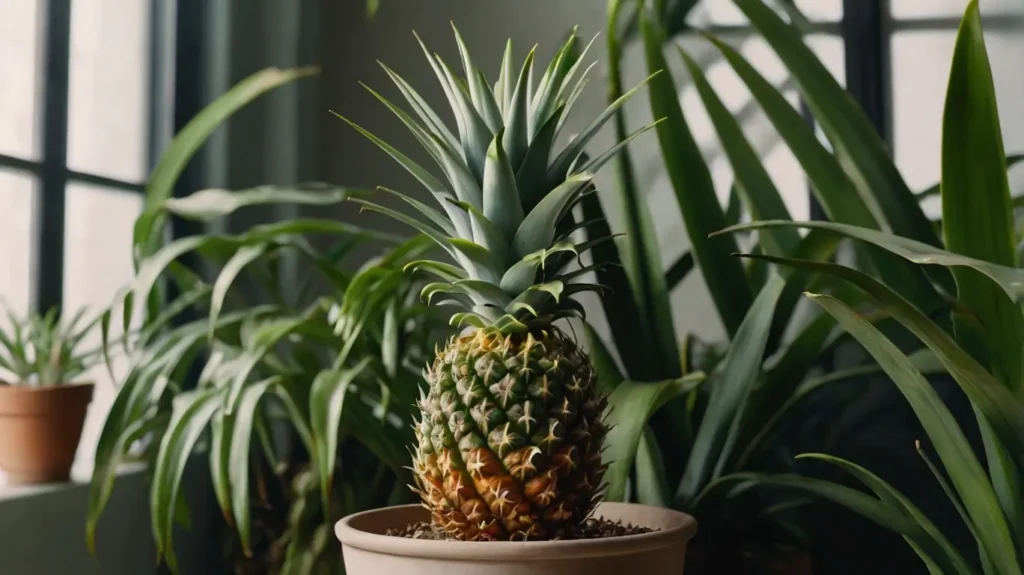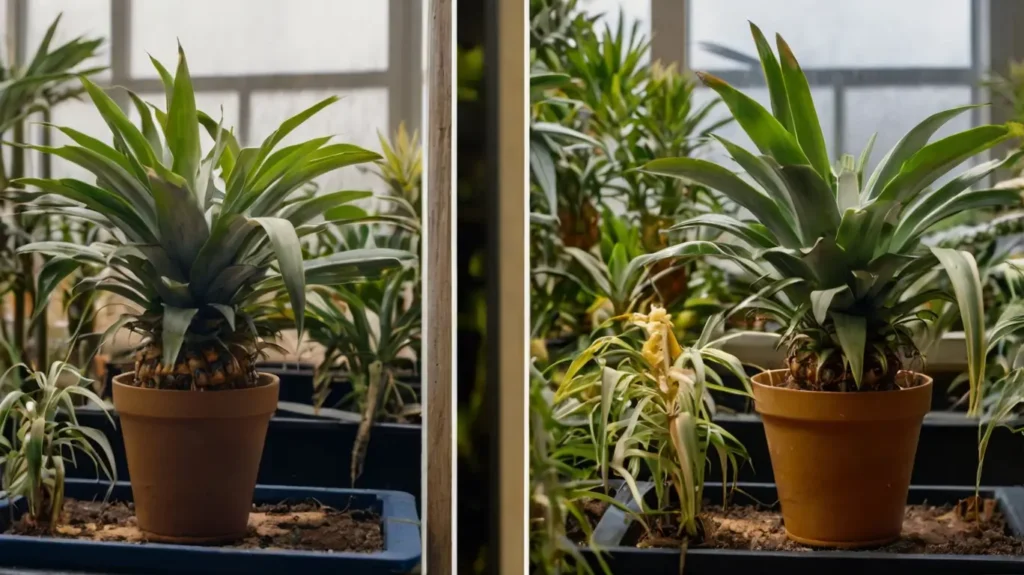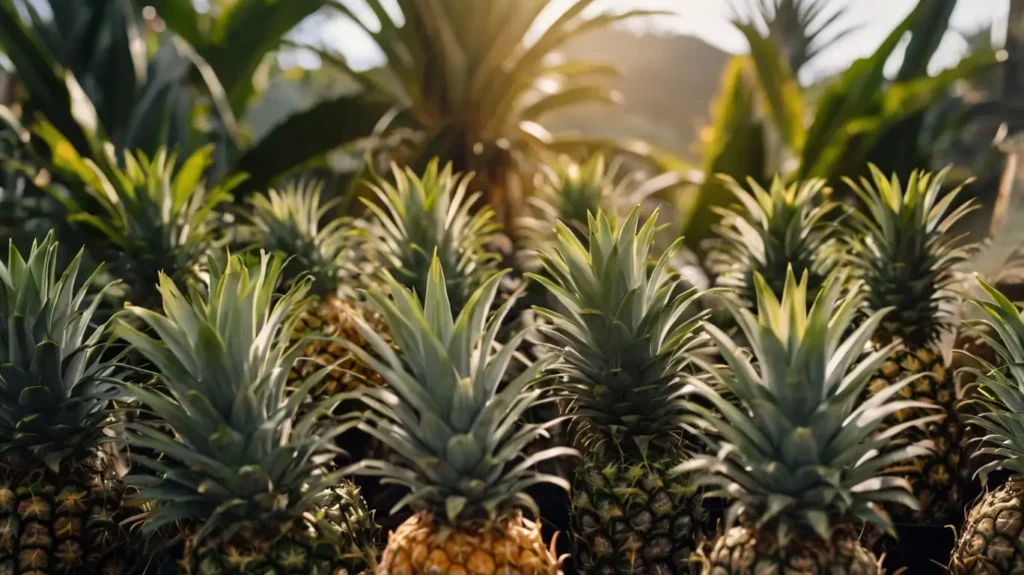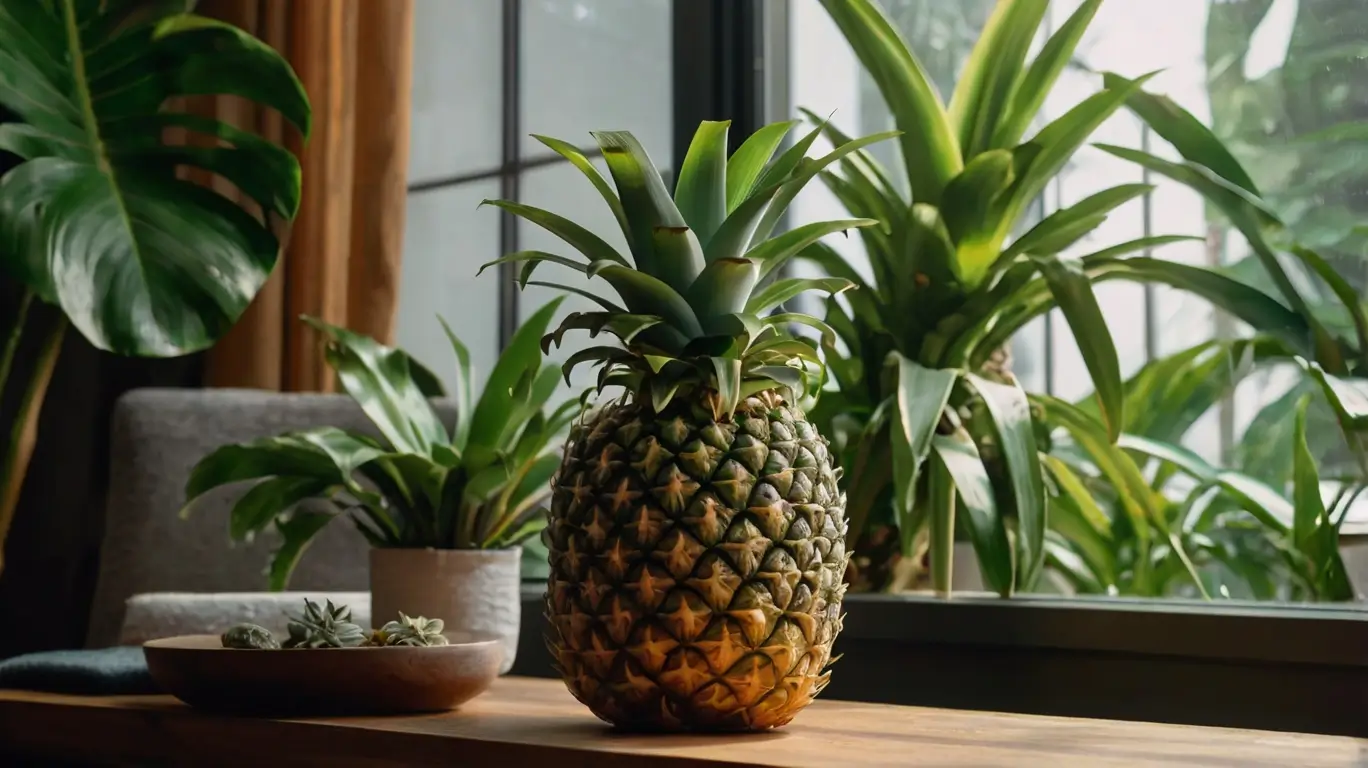Indoor Pineapple Plant: Brighten Up Your Home the Easy Way in 2025
Why the Indoor Pineapple Plant is a Game-Changer
Imagine this: It’s a regular afternoon, and you’re sitting in your living room, looking for something that could breathe life into the space.
Maybe your home feels a bit dull, or perhaps you’re simply searching for that special touch to elevate your decor.
Enter the indoor pineapple plant—a stunning, tropical addition that can completely transform the atmosphere in any room.
I’ll be honest: when I first introduced the indoor pineapple plant into my home, I wasn’t sure what to expect. Could such a small plant really make a difference? To my surprise, it did. Its vibrant, spiky leaves brought a burst of color that made my space feel more inviting and fresh.
It wasn’t just the plant’s unique look, though—it was the way it made me feel. Suddenly, my living room had a touch of tropical paradise right in the middle of the city. Who knew a plant could do that?
The indoor pineapple plant isn’t just a pretty face—it’s an excellent choice for anyone looking for a low-maintenance, high-impact addition to their home.
Whether you’re a seasoned plant enthusiast or just starting to explore indoor gardening, this tropical beauty is as easy to care for as it is eye-catching. It doesn’t demand constant attention but still gives back with its lush, exotic presence.
What makes the indoor pineapple plant even more remarkable is how adaptable it is. It thrives in bright, indirect light and requires little more than occasional watering and the right type of soil.
And let’s not forget the best part: it can grow fruit indoors. That’s right—your very own tiny pineapple could soon be sitting on your windowsill.
So, if you’ve been searching for a way to brighten up your home with a touch of nature that doesn’t require a green thumb, the indoor pineapple plant might just be the answer you’ve been looking for.
Stick around, and let’s explore why this plant could be the perfect fit for your home, no matter your gardening experience level.
What is an Indoor Pineapple Plant?

The indoor pineapple plant is a tropical beauty that can bring an exotic touch to your home. Scientifically known as Ananas comosus, this plant is typically grown outdoors in warm climates.
However, with the right care, it can thrive indoors just as well, making it a perfect choice for those looking to add a splash of greenery to their space.
While the indoor pineapple plant is best known for its fruit, it’s just as admired for its striking, spiky leaves and vibrant color. Its tropical origin gives it a distinct appearance that can brighten up any corner of your home.
Unlike larger, more demanding houseplants, the indoor pineapple plant stays relatively compact, making it ideal for small spaces or apartments.
Although its tropical nature suggests it might be high-maintenance, the indoor pineapple plant is surprisingly low-maintenance when grown indoors.
It thrives in conditions that most houseplants love: bright, indirect light, well-draining soil, and moderate humidity. Plus, its size makes it a perfect fit for windowsills, countertops, or even office desks, adding a vibrant splash without overwhelming your space.
How Does the Indoor Pineapple Plant Grow?
When you decide to grow an indoor pineapple plant, the growth cycle can be an exciting experience. Here’s a breakdown of what you can expect as it grows from a small pineapple top into a tropical showstopper:
- Planting the Pineapple Top:
The journey starts with a simple pineapple top, which you can cut from the fruit and let it dry for a few days before planting. Place it in well-draining soil, ideally in a pot with good drainage to avoid root rot. - Roots and Early Growth:
The indoor pineapple plant will begin to grow roots after about 2–3 weeks. At this stage, you’ll notice the base of the plant starting to establish itself, and the pineapple top will begin to sprout leaves. During this phase, it’s essential to keep the plant in a sunny spot with indirect light. - Ongoing Growth and Care:
As the indoor pineapple plant matures, its leaves will become more prominent, and the plant will start showing the unique spiky foliage that it’s known for. At this stage, you should continue to water it sparingly, ensuring the soil stays moist but not soggy. Regularly check for signs of new growth, and watch as the plant slowly takes shape. - Fruiting Stage:
After 2–3 years, the indoor pineapple plant may reward your patience with a small, delicious pineapple. Fruiting occurs when the plant reaches its full maturity, and it requires specific conditions such as consistent light, proper temperature, and adequate humidity. While fruiting isn’t guaranteed indoors, some lucky growers have seen their indoor pineapple plant produce fruit in small containers.
Growth Tips for Your Indoor Pineapple Plant
To help your indoor pineapple plant thrive, here are a few essential care tips to keep in mind as it moves through each growth stage:
- Light: Ensure the indoor pineapple plant gets plenty of indirect sunlight. Ideally, place it near a window where it can bask in bright light for a few hours each day. Too much direct sunlight may scorch its leaves, so always aim for that perfect balance.
- Temperature: The indoor pineapple plant enjoys warmth, so keep it in an area with temperatures ranging from 65°F to 85°F (18°C to 29°C). If the temperature drops below 50°F (10°C), it can damage the plant.
- Humidity: Like most tropical plants, the indoor pineapple plant thrives in a humid environment. If you live in a dry area, consider using a humidifier or placing a tray of water near the plant to boost moisture levels in the air.
- Watering: Water your indoor pineapple plant when the soil feels dry to the touch. Be sure to let the soil dry out between waterings to avoid root rot. A good rule of thumb is to water it once every 7–10 days, adjusting based on the season and indoor climate.
- Soil: A well-draining potting mix is essential for the health of your indoor pineapple plant. You can use a cactus or succulent mix, or mix in some sand with your regular potting soil to ensure good drainage.
By following these basic care guidelines, your indoor pineapple plant can grow strong and healthy, with the potential to produce the coveted tropical fruit.
Remember, it’s not a quick process, but it’s certainly a rewarding one. With patience and proper care, you’ll have a beautiful addition to your home and possibly even your very own pineapple to enjoy!
Why You Should Grow an Indoor Pineapple Plant
The indoor pineapple plant isn’t just a striking tropical specimen; it offers a wealth of benefits that can enhance both your living space and your mood.
Let’s dive into why this plant is more than just a pretty addition to your home.
Aesthetic Appeal
First and foremost, the indoor pineapple plant is a visual delight. Its spiky leaves form an eye-catching, architectural display that adds texture and depth to your decor. The plant’s bright green foliage is complemented by the potential for vibrant fruit, which can create a dramatic effect in any room.
Whether it’s the centerpiece of your coffee table or a decorative touch on a sunny windowsill, the indoor pineapple plant is sure to be a conversation starter.
Its bold, tropical look works beautifully in spaces that need a pop of color. It contrasts wonderfully with other plants or furniture, especially in rooms with neutral or earthy tones.
If you’re aiming for an exotic feel without overwhelming your space, the indoor pineapple plant can easily become your go-to decor piece.
Tropical Vibe
The allure of the tropics is irresistible. Who doesn’t want a little escape to a warm, sun-drenched beach? The indoor pineapple plant brings a slice of that dream into your home, infusing your space with a laid-back, tropical vibe.
The bold shape of its leaves and the potential for fruit production evoke an island atmosphere that can make any room feel more vibrant and inviting.
Imagine sitting in your living room, surrounded by plants, and glancing over at your indoor pineapple plant.
It instantly transports you to a more relaxed, carefree environment. If you live in a colder climate or want to recreate a vacation feel at home, this plant is the perfect addition. Even without fruit, its unique silhouette will have your space feeling more like a tropical retreat.
Health Benefits
While the health benefits of the indoor pineapple plant might not be as significant as those of some other houseplants, it still offers a couple of perks that can enhance your well-being. For starters, like many indoor plants, it can help purify the air.
Although its air-purifying abilities are minimal compared to larger plants, it still contributes to improving indoor air quality by removing toxins and releasing oxygen.
Additionally, caring for plants has been linked to reducing stress and anxiety, making the indoor pineapple plant a great companion in your home.
Its lush green leaves and tropical flair can have a soothing effect, bringing nature indoors and promoting a sense of calm. Simply tending to it can be a small but rewarding daily ritual.
Versatility in Home Decor
One of the best features of the indoor pineapple plant is its versatility in home decor. Whether you’re drawn to boho-chic vibes, minimalist styles, or a more contemporary aesthetic, this plant can easily fit in and complement various home themes.
- Boho Style: The indoor pineapple plant fits perfectly into boho-inspired interiors. Its wild, natural look adds texture and a touch of whimsy to spaces filled with textiles, woven rugs, and eclectic art. Place it near a window with sheer curtains for a soft, sun-kissed look.
- Minimalist Style: Even in more minimalist settings, the indoor pineapple plant can be a statement piece. Its clean lines and simple yet bold appearance make it ideal for minimalist spaces that focus on function and form. Try placing it on a modern, sleek shelf or countertop for a striking yet unobtrusive look.
- Contemporary Style: In a more modern home, the indoor pineapple plant’s sharp angles and tropical flair provide a refreshing contrast to sleek furniture and neutral tones. Place it in a ceramic pot or an understated container to enhance its tropical appeal without overwhelming the space.
Placement Suggestions
The indoor pineapple plant is adaptable when it comes to placement, but it thrives in bright, indirect light. Here are a few top spots to consider:
- Windowsills: The perfect location for the indoor pineapple plant. Place it on a sunny windowsill where it can catch the light without direct exposure, which could scorch its leaves.
- Kitchen Counters: The plant’s compact size makes it ideal for kitchen counters, especially if you have a space near a window. Imagine having a tiny tropical oasis while preparing meals!
- Sunny Corners: Find a bright corner in your living room, bedroom, or office, and place your indoor pineapple plant there. It will stand tall and proud, providing a focal point in the room.
In all cases, remember that good air circulation is key to keeping your indoor pineapple plant healthy.
How to Care for Your Indoor Pineapple Plant

Now that you’re convinced of the many reasons to grow the indoor pineapple plant, it’s time to talk about how to keep it thriving. Here’s a guide to its essential care requirements.
Light Requirements
The indoor pineapple plant craves bright, indirect sunlight. It thrives best when placed in a location that gets several hours of bright light each day but isn’t exposed to harsh, direct sun.
A sunny windowsill or a spot near a light-filled window would be ideal. Too much direct sunlight can scorch the leaves, so be mindful of where you place your plant.
Watering Needs
Watering the indoor pineapple plant requires a delicate balance. Like many tropical plants, it prefers moist soil but doesn’t like to be soggy.
The best approach is to water when the top inch of soil feels dry to the touch. During the warmer months, this could mean watering once a week, but in the cooler months, you may need to reduce the frequency. Always make sure the pot has good drainage to prevent water from sitting at the bottom.
Temperature and Humidity
The indoor pineapple plant enjoys warmth, so keep it in a space where temperatures stay between 65°F to 85°F (18°C to 29°C).
It also loves humidity, so if you live in a dry area, consider using a humidifier or placing the plant near other plants that can provide a moisture boost in the air.
Soil and Potting
A well-draining, sandy soil mix is ideal for the indoor pineapple plant. You can use a standard potting mix with added sand or perlite for improved drainage.
Be sure to plant it in a pot with drainage holes to avoid waterlogging, which could lead to root rot.
Fertilizing
To promote healthy growth, use a balanced, water-soluble fertilizer every two months during the growing season (spring through summer).
Dilute the fertilizer to about half-strength to avoid overfeeding, as the indoor pineapple plant is quite low-maintenance in this regard.
Common Mistakes to Avoid with Your Indoor Pineapple Plant

While the indoor pineapple plant is generally easy to care for, there are a few common mistakes that could hinder its growth. Here’s what to avoid:
- Overwatering: One of the most common mistakes with the indoor pineapple plant is overwatering. Ensure the soil has proper drainage and let it dry out between waterings to prevent root rot.
- Incorrect Lighting: Too much direct sunlight can scorch the leaves, while too little light will slow down growth. Aim for bright, indirect light to strike the right balance.
- Poor Soil Drainage: Make sure the pot has drainage holes, as the indoor pineapple plant does not like soggy soil. Good drainage helps prevent root rot and keeps the plant healthy.
- Lack of Patience: Growing fruit indoors takes time. If you’re waiting for that delicious pineapple, be patient—it can take 2–3 years before the plant fruits. Enjoy the process!
- Not Repotting: As the indoor pineapple plant grows, it may outgrow its pot. If you notice roots coming out of the drainage holes, it’s time to repot it into a slightly larger container.
Indoor Pineapple Plant: Fruit Production and What to Expect
One of the most rewarding aspects of growing an indoor pineapple plant is the possibility of harvesting your very own fruit. While it may take some time and care, it’s absolutely achievable with the right conditions.
Can You Grow Fruit Indoors?
Yes, it’s possible for an indoor pineapple plant to bear fruit, though it doesn’t happen overnight. In fact, it requires a combination of patience, proper care, and ideal conditions to see the fruit emerge.
The plant will start to produce its small, spiky fruit typically after 2 to 3 years of growth, making it a long-term project that requires some dedication.
Steps to Encourage Fruiting
- Pollination Tips: Pineapple plants are not self-pollinating, so if you want your indoor pineapple plant to produce fruit, you may need to assist with pollination. While bees and other insects often do the job outdoors, indoors, you can mimic this process by gently brushing the flowers with a soft paintbrush or cotton swab to transfer pollen from one flower to another.
- Temperature Control: Pineapples are tropical plants, so maintaining consistent warmth is key to fruit production. Keep your indoor pineapple plant in temperatures between 65°F and 85°F (18°C and 29°C). Avoid sudden temperature changes, as they can stress the plant and hinder fruiting.
- Patience: As mentioned, it can take up to 3 years for your indoor pineapple plant to produce fruit, but it’s a long but rewarding journey. Watching the plant grow and gradually show signs of fruit is an incredible experience. The small fruits that eventually emerge are a testament to your care and patience.
Is It Worth the Wait?
Absolutely! There’s something undeniably satisfying about growing your own tropical fruit, even if it’s on a small scale.
Although the indoor pineapple plant doesn’t bear fruit as quickly or as abundantly as larger outdoor plants, the process of nurturing it and eventually seeing the small, golden fruit is a sense of accomplishment.
And when you finally get to taste the fruit of your labor (pun intended), it makes the wait even more worth it.
Troubleshooting: How to Deal with Common Issues
Like all plants, the indoor pineapple plant can face a few issues along the way. Here are some common challenges and how to handle them.
Pests and Diseases
Pests such as mealybugs and aphids can occasionally target your indoor pineapple plant, particularly if it’s stressed or if there’s high humidity. To treat these pests:
- Mealybugs: You can dab them with a cotton swab soaked in rubbing alcohol, or use insecticidal soap.
- Aphids: Try spraying the plant with a mixture of water and mild dish soap to dislodge these pests.
Always inspect your plant regularly to catch pests early before they cause significant damage.
Yellowing Leaves
If your indoor pineapple plant develops yellowing leaves, this could be a sign of several potential problems:
- Overwatering: If the soil stays too wet for too long, it can cause root rot, leading to yellowing leaves. Ensure your plant has a well-draining pot and allow the soil to dry out between waterings.
- Low Light: Pineapples need plenty of bright, indirect light. If your plant isn’t getting enough light, it may struggle and show signs of stress, like yellowing leaves.
- Nutrient Deficiencies: If you haven’t fertilized your indoor pineapple plant in a while, it could be lacking essential nutrients. Try using a balanced, water-soluble fertilizer to support its growth.
Slow Growth
If your indoor pineapple plant is growing slowly, several factors might be at play:
- Inadequate Sunlight: Pineapple plants need plenty of bright light to thrive. Ensure your plant is in a spot that gets several hours of indirect sunlight daily.
- Under-fertilization: Without regular feeding, your plant may not grow as quickly. Feed your indoor pineapple plant with a balanced fertilizer every couple of months to encourage strong growth.
- Too Much Humidity: While tropical plants love humidity, too much can hinder growth. If your space is very humid, try moving the plant to a slightly less humid area to see if that helps.
How to Keep Your Plant Happy Year-Round
Keeping your indoor pineapple plant happy year-round requires a few seasonal adjustments. Here’s how you can ensure your plant continues to thrive throughout the year:
- Winter Care: In colder months, consider moving your plant to a brighter spot, as natural light can become scarce. Additionally, use a humidifier to maintain moisture in the air and prevent the plant from drying out.
- Summer Care: During the warmer months, your indoor pineapple plant will likely thrive with the increased sunlight. Just make sure to rotate the pot regularly to ensure even sunlight exposure.
As your indoor pineapple plant matures, you may need to adjust your care routine. Larger plants may require more frequent watering or a bigger pot, so keep an eye on the size and needs of your plant as it grows.
The Benefits of Growing an Indoor Pineapple Plant
Growing an indoor pineapple plant offers more than just a beautiful addition to your home. Here are a few reasons why it’s worth the effort:
- Sense of Accomplishment: There’s something incredibly satisfying about growing your own fruit. Watching your indoor pineapple plant thrive and eventually bear fruit is a rewarding experience.
- Brings Nature Indoors: Even if you’re not a seasoned gardener, the indoor pineapple plant is an easy way to bring a bit of nature indoors. It offers a refreshing tropical vibe that livens up any room.
- Conversation Starter: Your indoor pineapple plant is sure to catch the attention of guests and visitors. It’s a unique feature that will spark conversations and admiration, making it a standout piece in your home.
Conclusion
The indoor pineapple plant is an excellent choice for anyone looking to brighten up their home with a tropical touch.
Whether you’re drawn to its aesthetic appeal, the possibility of growing fruit, or the simple joy of nurturing a plant, it’s a perfect addition to any space. And the best part? It’s easy to care for and can thrive even in smaller spaces.
Give it a try! If you’ve ever thought about growing your own tropical fruit indoors, the indoor pineapple plant is your opportunity.
Share your experiences and tips in the comments below, and don’t forget to check out other related articles on plant care and indoor gardening.
Frequently Asked Questions (FAQ)
How much sunlight does an indoor pineapple plant need?
The indoor pineapple plant needs bright, indirect light. Direct sunlight might scorch its leaves, so ensure it gets a few hours of indirect sunlight each day.
Can I grow an indoor pineapple plant from the top of a store-bought pineapple?
Yes! You can cut off the top of a store-bought pineapple, allow it to dry, and then plant it in soil to grow your own indoor pineapple plant.
How long does it take for an indoor pineapple plant to produce fruit?
It typically takes about 2 to 3 years for an indoor pineapple plant to bear fruit.
What is the best soil for growing an indoor pineapple plant?
Well-draining, sandy, or loamy soil works best for indoor pineapple plants.
Can I grow an indoor pineapple plant in a pot?
Yes! A pot with good drainage is ideal for growing your indoor pineapple plant.
Indoor Pineapple Plant Care Guide
| Care Aspect | Recommended | Tips |
|---|---|---|
| Light | Bright, indirect light | Rotate plant for even sunlight |
| Watering | Keep soil moist, but not waterlogged | Use well-draining pot |
| Temperature | 65°F to 85°F (18°C to 29°C) | Avoid sudden temperature drops |
| Fertilizing | Once a month with balanced fertilizer | Dilute fertilizer to avoid overfeeding |

